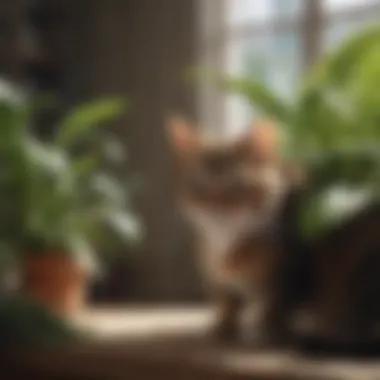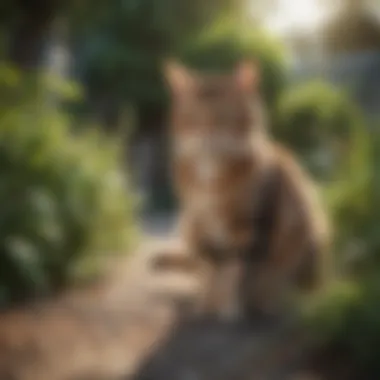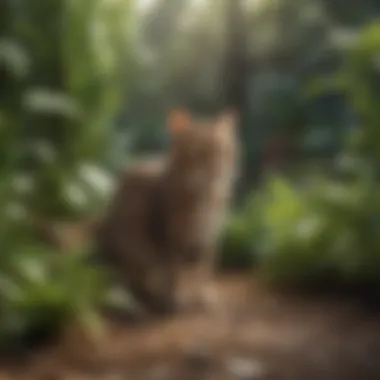Effective Strategies to Keep Cats Away from Your Plants


Intro
Cats, known for their natural curiosity, often find solace in the greenery of our homes and gardens. Their affinity for plants can cause significant damage, disrupting the carefully curated environment that plant owners strive to maintain. This article explores various strategic approaches to deter cats from interfering with both indoor and outdoor plants. Understanding feline behavior is central to implementing effective deterrent techniques. Through this guide, you will discover practical solutions to protect your plants while ensuring feline welfare.
Understanding Cat Behavior
Before delving into methods of deterrence, it is crucial to understand why cats are drawn to plants. Cats possess a natural instinct to explore their surroundings. Plants often pique their interest either as toys or as potential hiding spots. Moreover, certain plants have scents and textures that attract cats, making them irresistibly appealing.
Key Points:
- Cats are explorers, often investigating new objects in their environment.
- Some plants may provide sensory stimulation or play opportunities for cats.
- A thorough understanding of these tendencies can guide effective repelling strategies.
Strategic Deterrents
Equipped with insights about cat behavior, plant owners can adopt various deterrent strategies to protect their greenery. This section reviews both natural and artificial methods that can minimize unwanted feline interaction with plants.
Natural Deterrents
Certain herbs and scents can deter cats effectively. Here’s a list of natural deterrents:
- Citrus Peels: Cats often dislike the smell of citrus fruits such as oranges and lemons. Placing peels around plants can help keep them at bay.
- Vinegar: A mixture of vinegar and water sprayed around plants can create an unpleasant aroma for cats.
- Coffee Grounds: Cats are known to dislike the smell of coffee. Sprinkling used coffee grounds around plants may deter them.
Effective Use of Natural Deterrents
Utilizing natural deterrents involves regular reapplication and experimentation with different scents to find what works best for your specific setting.
Artificial Deterrents
There is a range of commercial products designed to deter cats from plants. These may include:
- Motion-Activated Sprinklers: These devices can deter cats by spraying water when motion is detected.
- Ultrasonic Repellents: These gadgets emit a sound that is annoying to cats but inaudible to humans, effectively keeping them away.
Best Practices for Deterring Cats
Implementing best practices increases the effectiveness of these deterrent strategies:
- Placement: Position deterrents strategically near vulnerable plants or areas.
- Consistency: Consistency in applying and maintaining these methods is key to long-term success.
Important Note: It is essential to ensure that the methods employed are humane and do not cause distress to the cat.
Harmonizing Environment
Creating a harmonious environment where both cats and plants can coexist requires careful planning. One approach is to designate areas specifically for cats, such as crafting a cat-friendly garden. This could include catnip plants or other items that entice your feline away from more precious greenery.
Ending
Repelling cats from plants is a significant concern for many plant owners. By understanding feline behavior and employing effective strategies, it is possible to protect greenery while ensuring that cats are not harmed in the process. The methods covered in this article are merely starting points. Each cat and environment is unique, and finding the right balance may take some time and effort.
Foreword to the Problem
Dealing with the presence of cats around plants is a common issue for many plant owners. Cats, whether they are pets or neighborhood strays, often find intrigue in greenery. Their instinctual behavior leads them to dig, nibble, or lounge among the plants, causing damage and distress. This situation presents not just a challenge for gardening enthusiasts but also raises concerns about the plants' health and longevity. Understanding the root causes of this problem is essential.
Understanding Cat Behavior
Cats are inherently curious creatures. Their natural instincts drive them to explore their surroundings and investigate anything that appears new or interesting. When it comes to plants, several factors attract feline attention. The textures of leaves, the earthy smell of soil, and even the presence of insects can compel cats to interact with houseplants or gardens.
Additionally, many cats are drawn to specific plants like catnip or grass, which can lead them to venture toward other, less desirable plants. Knowing these behavioral patterns helps in strategizing effective ways to deter them. Plant owners can benefit from recognizing these instinctual tendencies, as understanding the underlying motivations can inform the creation of solutions that work both for the plants and the cats.


Impact of Cats on Plants
The interaction between cats and plants is often more damaging than mere playfulness. Cats may scratch or nibble on leaves, leading to unsightly damage and potential plant death. Soil disruption is another common issue, as cats might dig in pots, uprooting delicate roots and compromising the plant's structure.
Furthermore, some plants can be toxic to cats if ingested. This not only poses a risk to feline health but also creates a cycle of repelling cats that may not be necessary with safe plant selections.
In summary, it is crucial for plant owners to understand the harmful effects cats can have on their greenery. By adopting strategic approaches to manage these interactions, it is possible to keep both the plants flourishing and the cats safe.
Identifying the Reasons Cats Are Attracted to Plants
Understanding why cats are drawn to plants is crucial for determining effective deterrent strategies. Cats are naturally curious creatures. Analyzing their attraction to greenery can lead to insights about their behavior and natural instincts. Potentially harmful interactions with plants can be avoided by recognizing these motivations. Addressing the underlying reasons can also promote a safer environment for both the plants and the cats.
Natural Instincts
Cats have innate behaviors that lead them to explore and interact with plants. They are instinctual hunters, and the rustle of leaves or movement can stimulate their predatory nature. Such actions can be very intriguing. Additionally, many cats exhibit behaviors tied to instincts, such as climbing and jumping, which can lead them to plant areas. Understanding these instincts is important. It helps you frame strategies to redirect their attention or to create barriers that minimize access to plants.
Curiosity and Exploration
Curiosity drives feline behavior significantly. Cats tend to investigate their environment, including fragrant plants. They may venture into certain areas just to explore. This exploration can cause unintentional harm to your plants, especially if they begin to dig or chew. Recognizing this aspect of cat behavior allows pet owners to anticipate interactions. By identifying which plants attract a cat's curiosity, owners can implement specific strategies to mitigate potential damage.
Potential Food Sources
For some cats, plants may represent more than just curiosity. Certain types of greenery might be perceived as food sources. Cats are obligate carnivores, but many are attracted to specific plants which are safe for them to consume. For example, grasses can aid in digestion or help induce vomiting to clear hairballs. Recognizing which plants are appealing and might present an irresistible temptation can influence how you manage your home or garden. By removing these potential food sources or substituting them with alternatives, you can effectively deter cats from lingering around your plant collection.
Understanding the reasons why cats are attracted to plants helps in crafting an effective strategy for protection. Recognizing their natural instincts, curiosity, and dietary preferences is essential for success.
Behavioral Modification Techniques
Behavioral modification techniques play a crucial role in managing the interaction between cats and plants. Understanding feline behavior is essential to create strategies that discourage unwanted habits. These techniques focus on redirecting a cat's natural instincts, providing alternative activities, and establishing environments that protect both plants and cats.
Implementing behavioral modification offers numerous benefits. Firstly, it promotes a more harmonious living space where plants are safe from feline curiosity. Secondly, it can improve the overall well-being of the cat by engaging them in stimulating activities that satisfy their instincts.
A few considerations must be kept in mind. Each cat is unique, and what works for one may not work for another. Moreover, consistency is vital for effective behavioral modification. It may take time for both the cat and owner to adapt to new routines.
Creating a Cat-Free Zone
Creating a cat-free zone is an effective way to protect plants. Designate specific areas in your home or garden where cats are not allowed. This can be achieved through physical barriers or strategic placement of plants.
Selecting locations that are less accessible to cats helps in maintaining the integrity of your greenery. For example, placing plants on higher shelves or in hanging pots can deter cats from reaching them. Additionally, using baby gates or closed doors can further reinforce boundaries.
Redirecting Attention
Redirecting attention is another useful approach. This technique involves engaging the cat in alternative activities to shift their focus awy from your plants.
Utilizing Cat Toys
Utilizing cat toys is a practical method to capture your cat's interest. These toys come in various forms, such as interactive puzzles and simple balls. A key characteristic of cat toys is their ability to engage cats mentally and physically.
Cats are generally drawn to objects that mimic prey, triggering their hunting instincts. By providing an array of toys, you create distractions that allow them to expend energy constructively. One unique feature of these toys is their versatility; they can be switched out frequently to maintain novelty, keeping the cat engaged. However, it is important to supervise playtime to avoid potential ingestion of smaller parts.
Engaging Playtime
Engaging playtime is essential in maintaining a cat's physical and mental health. This approach involves dedicating regular time to actively interact with your cat. A critical aspect of engaging playtime is its capacity to strengthen the bond between you and your pet while focusing their energy in a positive direction.
Through activities like feather wands or laser pointers, you encourage exercise and mental stimulation. This can reduce their interest in plants as they find satisfaction in other pursuits. An advantage is that it can make your cat feel more fulfilled, but it requires commitment and consistency from you.
Regular engagement not only keeps your cat entertained but also helps prevent destructive behaviors towards your indoor or outdoor plants.


Natural Deterrents
Natural deterrents represent a fundamental approach for plant owners seeking to minimize feline interference. Utilizing substances found in nature offers several advantages. They are generally safer for both cats and plants compared to synthetic solutions. Moreover, natural deterrents often integrate seamlessly into a garden's ecology without disrupting the delicate balance required for healthy plant growth.
Natural deterrents can take many forms. Some may even contribute positively to the overall aroma of your living space or garden, making the environment more pleasant while serving a practical purpose. Understanding the elements at play in these deterrents allows for a more effective strategy for protecting plants.
Citrus Scents
Citrus scents are well-known for their ability to repel cats effectively. Many cats overwhelmingly dislike the aroma of citrus fruits such as lemons, limes, and oranges. This aversion allows plant owners to leverage these scents to their advantage. You can use the peels of these fruits as a deterrent by scattering them around your plants. Alternatively, creating a citrus-infused spray is an effective strategy.
To make this spray, mix the juice from citrus fruits with water in a spray bottle. A ratio of 1:4 (one part juice to four parts water) generally works well. Then simply spritz this mixture around the base of your plants. The fragrant barrier it creates will dissuade cats from approaching while also leaving a refreshing scent.
Herbs That Deter Cats
Certain herbs possess an intrinsic ability to act as natural repellents for cats. Notable examples include lavender, rosemary, and rue. Each herb not only fights off feline curiosity but can also provide aesthetic and olfactory benefits for human visitors.
- Lavender is renowned for its calming effects, making it popular in gardens. Some cats may find the scent irritating, thus keeping them at bay.
- Rosemary has a strong, woody fragrance that can also work as an effective barrier against cat activity.
- Rue is perhaps the most potent herb for repelling cats. Its odor is quite disagreeable to felines, making it a wise choice for those serious about safeguarding their plants.
Planting these herbs in strategic locations throughout your garden can create a natural protective barrier. Furthermore, frequent pruning ensures that the herbs remain healthy and potent, maximizing their deterrent properties.
Essential Oils to Consider
Essential oils can also serve as powerful natural deterrents. Certain oils are particularly effective due to their concentrated nature. Peppermint oil, citronella oil, and eucalyptus oil are among the leading options. Utilizing essential oils requires careful application to avoid harming plants.
One way to use essential oils is to dilute a small quantity in water and create a spray solution. A typical ratio can range from 10 to 20 drops of essential oil in a quart of water. Ensure to test this solution on a small section of your plant first, as certain plants may be sensitive to oils.
Commercial Deterrent Products
Commercial deterrent products play a crucial role in managing the interaction between cats and plants. These products provide immediate solutions for pet owners who cannot constantly supervise their cats. The effectiveness of these deterrents often depends on their type, composition, and usability within different environments. By incorporating these products, owners can create an atmosphere that discourages cats from treating their plants as play areas or chew toys.
Choosing the right commercial deterrent can lead to several benefits. First, these products can be designed to be safe for both plants and cats, ensuring that they do not cause harm while providing effective results. Second, they can be readily available and easy to apply, which is essential for busy lives. However, it is important to consider the variety of options available in the market and determine what best fits your needs.
"Commercial deterrents offer immediate solutions for pet owners struggling to keep plants safe from their feline companions."
Sprays and Granules
Sprays and granules are two of the most common forms of commercial deterrents. They typically use ingredients that cats find unpleasant, such as bitter or citrus scents. Sprays can be applied directly to the plants, while granules may be spread around the base of the plant or garden area.
When using sprays, it's important to select products that are specifically labeled as safe for plants. These sprays can offer a long-lasting barrier against cats. Regular reapplication may be necessary, especially after rain or watering.
Granular deterrents often serve a dual purpose. They can act as a barrier while also providing some fertilizer benefits. Making a choice between sprays and granules may depend on the environment - granules may work better outdoors, whereas sprays may be more suitable for indoor plants.
Key points to consider with sprays and granules include:
- Safety for plants and cats
- Ease of application
- Duration of effectiveness
- Environmental factors that may affect performance
Motion-Activated Devices
Motion-activated devices represent a more high-tech approach to deterring cats from plants. These devices function by detecting movement and reacting with sounds, sprays, or sudden movements, which startles cats away from the vicinity of the plants. The concept is built on their instinctual reactions to unexpected stimuli.
These devices can be particularly effective in large areas, such as gardens or yards, where it may be difficult to monitor all plants at once. They not only keep cats away but can also serve as a deterrent to other pests. Moreover, some motion-activated devices can be programmed for different sensitivity levels, allowing customization for various environments.
However, potential drawbacks include:
- Reliance on power source
- Initial cost may be higher than traditional methods
- Possible ineffectiveness in windy conditions or when other animals trigger the device
When selecting motion-activated devices, it is vital to assess quality and durability to ensure long-term functionality. Their presence can significantly change the dynamics between cats and plants, helping to safeguard greenery without constant supervision.


Plant Selection and Arrangement
Selecting the right plants and arranging them appropriately can significantly influence your success in deterring cats. The choice of plants plays a key role in creating a space that is less appealing to feline visitors. Understanding which plants are less favorable to cats can save your greenery from destruction while keeping your home harmonious.
Choosing Non-Cat-Friendly Plants
In this regard, it is essential to select plants that are not only visually appealing but also undesirable for cats. Some plants have natural features that deter cats, either through their fragrance or texture. For instance, Coleus canina, commonly known as the
Creating a Safe Environment for Both Cats and Plants
Creating a safe environment for both cats and plants involves striking a delicate balance between preserving the vitality of your greenery and ensuring the well-being of your feline companions. This approach is crucial because it recognizes that both plants and cats play significant roles in a household. Plant lovers often put efforts into cultivating diverse and healthy plants, while simultaneously, cats have their own natural instincts and curious behaviors that can lead to unintentional damage.
The key elements to consider include understanding the behaviors of cats alongside using effective deterrent strategies. When cats are educated and boundaries are established, the likelihood of conflict reduces greatly. Ensuring a safe environment not only keeps plants thriving but also promotes a positive space for the cat.
Benefits of this approach include:
- Enhanced Plant Health: When cats are deterred from destructive behaviors, plants can grow without being uprooted or chewed.
- Feline Well-being: Cats find routines and boundaries comforting. Educated pets tend to display less anxiety.
- Improved Harmony: A household where both plants and cats coexist peacefully is more enjoyable for everyone.
Prioritizing a safe environment pays off in the long run. Whether it involves specific training techniques or setting physical boundaries, it leads to equitable results for all parties involved.
Educating Your Cat
Educating your cat is a foundation of creating a safe space. Cats are intelligent creatures that can learn from their experiences. Positive reinforcement training can help them understand which behaviors are acceptable and which are not. Training should focus on redirecting attention from the plants to compatible activities. For example, you can incorporate toys or interactive play to keep your cat’s instincts engaged without harming your plants.
Consider the following strategies for successfully educating your cat:
- Use Treats: Reward your cat for avoiding the plants. Positive association helps build desirable habits.
- Incorporate Play: Engage the cat with toys that mimic their natural hunting instincts to divert their focus.
- Observe Behavior: Identify specific plants that attract your cat, modifying the approach accordingly.
By actively participating in your cat's learning process, you help reinforce boundaries, leading to less stress for both the cat and the plants.
Establishing Boundaries
Establishing boundaries is the next vital step in maintaining a safe environment. Clear physical and behavioral boundaries can prevent unwanted interactions with your plants. Here are a few practical tips:
- Physical Barriers: Consider using decorative netting or fences around vulnerable plants to deter cats.
- Designated Areas: Create separate areas in your environment where your cat can explore freely, avoiding plant-filled zones.
- Consistent Routine: Cats respond well to routines. Ensure that they know when it's playtime and when to stay away from specific areas.
By setting firm boundaries, you can minimize negative behavior, leading to a more secure space for both your plants and your cat.
Remember, both plants and cats need their space respected. A little patience and understanding go a long way in achieving harmony at home.
Finale
Understanding the strategies to repel cats from plants is essential for any pet owner or plant enthusiast. This article has outlined comprehensive methods for creating a balance between nurturing plant life and ensuring that feline companions do not interfere. By implementing these tactics, you not only protect your greenery but also contribute to a peaceful environment.
One cannot overlook the significance of managing both cats and plants effectively. The strategies discussed serve several purposes:
- Protection of Plants: With various methods, such as natural and commercial deterrents, your plants can thrive without damage.
- Fostering Cat Well-Being: Allowing cats to express their natural behaviors without harming plants leads to healthier households.
- Building Awareness: Educating pet owners about effective deterrents ensures a more harmonious living environment.
Also, this guide emphasizes the long-term commitment required to maintain this balance. Incorporating these approaches requires consistency and observation, which can greatly enhance the relationship between your pets and your indoor or outdoor plants.
Recap of Strategies
This article has explored multiple avenues to keep cats at bay from your greenery. Key strategies include the following:
- Behavioral Modification Techniques: Creating designated zones for cats and redirecting their attention through toys and activities.
- Natural Deterrents: Utilizing citrus scents and certain herbs that cats tend to avoid.
- Commercial Products: Such as motion-sensors and sprays designed to deter cats effectively.
- Plant Selection: Choosing varieties that are less appealing to felines, along with strategic placement.
- Safe Environment: Establishing boundaries and educating your cats on acceptable behaviors helps to mitigate conflicts between plant care and feline curiosity.
By incorporating these strategies, you foster a more peaceful coexistence in your living space.
Long-term Solutions for Plant Lovers
Moving forward, there are several aspects to consider for creating a sustainable environment:
- Consistent Enforcement: Regularly engaging in the methods established helps reinforce desired behaviors in both plants and cats.
- Monitoring Plant Health: Observing the interaction between your pets and plants allows for timely adjustments to your strategies.
- Adapting to Changes: As your pets grow and learn, you may need to adapt your approach to ensure continued success. Regular assessment of behaviors will guide new solutions if necessary.















